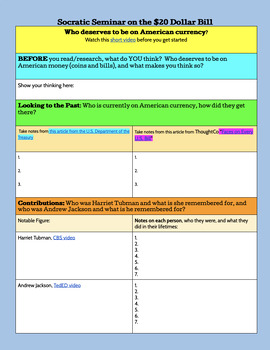Socratic Seminar: Who Should Be on American Currency?
And Literacy For All
3 Followers
Grade Levels
8th - 12th, Homeschool
Subjects
Resource Type
Standards
CCSSRI.9-10.9
CCSSRI.9-10.10
CCSSRI.11-12.1
CCSSRI.11-12.7
CCSSRI.11-12.8
Formats Included
- Google Docs™
- Internet Activities
- Webquests
Pages
2 pages
And Literacy For All
3 Followers

Made for Google Drive™
This resource can be used by students on Google Drive or Google Classroom. To access this resource, you’ll need to allow TPT to add it to your Google Drive. See our FAQ and Privacy Policy for more information.
Description
The images we see around us daily have a subtle yet profound effect. In this Socratic seminar, students consider American currency and consider: should the faces on the bills be changed or stay the same? The learn who is featured on currency now and think on who could be. This activity can be used during an American History course as students learn about figures like Andrew Jackson and Harriet Tubman, or can be used as a general debate in any Social Studies or English-Language Arts classroom.
Total Pages
2 pages
Answer Key
N/A
Teaching Duration
2 days
Report this resource to TPT
Reported resources will be reviewed by our team. Report this resource to let us know if this resource violates TPT’s content guidelines.
Standards
to see state-specific standards (only available in the US).
CCSSRI.9-10.9
Analyze seminal U.S. documents of historical and literary significance (e.g., Washington’s Farewell Address, the Gettysburg Address, Roosevelt’s Four Freedoms speech, King’s “Letter from Birmingham Jail”), including how they address related themes and concepts.
CCSSRI.9-10.10
By the end of grade 9, read and comprehend literary nonfiction in the grades 9-10 text complexity band proficiently, with scaffolding as needed at the high end of the range.By the end of grade 10, read and comprehend literary nonfiction at the high end of the grades 9-10 text complexity band independently and proficiently.
CCSSRI.11-12.1
Cite strong and thorough textual evidence to support analysis of what the text says explicitly as well as inferences drawn from the text, including determining where the text leaves matters uncertain.
CCSSRI.11-12.7
Integrate and evaluate multiple sources of information presented in different media or formats (e.g., visually, quantitatively) as well as in words in order to address a question or solve a problem.
CCSSRI.11-12.8
Delineate and evaluate the reasoning in seminal U.S. texts, including the application of constitutional principles and use of legal reasoning (e.g., in U.S. Supreme Court majority opinions and dissents) and the premises, purposes, and arguments in works of public advocacy (e.g., The Federalist, presidential addresses).


